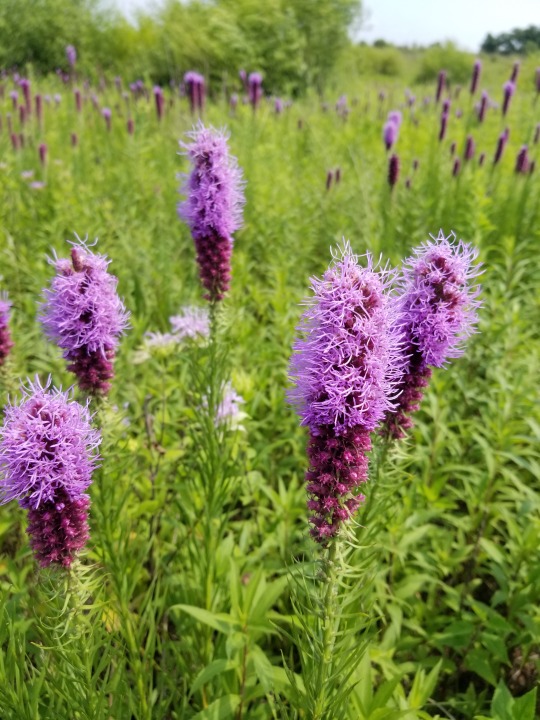#Liatris Spicata
Explore tagged Tumblr posts
Text




3 notes
·
View notes
Text
Liatris Spicata - Marsh Blazing Star
native
Aster Family (Asteraceae)

Notes: Dr. Seuss ass looking plant. These are so fascinating to me and the pollinators love them. We have planted so many in this genus that it's going to be really special seeing them through the year. This one was also being bullied by the hibiscus and is really leaning trying to find sun. It's just the beginning of this one's bloom but I've been behind so we're getting the pic at this stage.
#Liatris Spicata#Marsh Blazing Star#Asteraceae#Aster Family#In Yard#Native#I planted this#Planted 2023#illinois native plant#July#Purple#z2
0 notes
Text

Liatris spicata / Dense Blazing Star at the Sarah P. Duke Gardens at Duke University in Durham, NC
#Liatris spicata#Liatris#Dense Blazing Star#Blazing Star#Native plants#Native flowers#Flowers#Nature photography#photographers on tumblr#Sarah P. Duke Gardens#Duke Gardens#Durham#Durham NC#North Carolina
3 notes
·
View notes
Photo

#liatris spicata#Jindai Botanical Garden#Tokyo#リアトリス・スピカタ#神代植物公園#東京#HD PENTAX-DA 20-40mm F2.8-4 Limited
2 notes
·
View notes
Text


If you're looking for plants that have names as fun as they are, look no further than gayfeather! Gayfeather (Liatris spicata, also known as prairie feather and dense blazing star) is a colorful Midwestern prairie plant that attracts plenty butterflies, bees, and even our native ruby-throated hummingbirds. It thrives on moist, often sandy soil. Indigenous people of the Midwest used this plant for a number of medicinal purposes, but today it's primarily used as a gorgeous, perennial ornamental plant and to attract pollinators to gardens.
98 notes
·
View notes
Text

Babies
2 notes
·
View notes
Photo



Liatris spicata,
Spiked/Marsh Blazing Star. On the edge of Adena Mound Prairie Restoration and Savanna remnant at Glenwood Gardens, Cincinnati, Ohio.
In my region of the United States this species of Liatris is perhaps the most common; while it does better in more hydrologically active scenario, it can thrive in rocky drainage basins and I’ve even seen it in intact dry prairie functioning fine. It’s spikes are a classic aggregate of nearly sessile attached capitulum composed of florets with iridescent purple elongate stigma that are very noticeable and highly attractive to the vast majority of butterflies and bees. As a nectar species this species is a boon and frequently replenishes nectaries. The roots of this species are a interesting one to study as they are known to be sought out by prairie voles for food, these roots being targeted frequently may be linked to chemical secretions that benefit the soil. Liatris spicata roots are densely fibrous and have a corm that forms many clonal propagules; these roots also are known to provide aeration and hydrologically useful improvements during periods of saturation and periods like vernal dam or frost heaving periods. Liatris spicata corms are considered medically useful as well; research on such extractions provide evidence that it aids in anti-microbial and blood thinning effects, some anti viral research can be found but it seems nebulous and not as frequently researched. This medically active association should be approached with caution as the chemically active organic group is Coumarins or more specifically “ Coumarin ((1,2-benzopyrone), C9H6O2)”.
<3 me some voles
https://pubchem.ncbi.nlm.nih.gov/compound/323 - compound
https://www.dnr.state.mn.us/rsg/profile.html?action=elementDetail&selectedElement=AMAFF11140 - vole
https://webstu.onu.edu/garden/node/453 - on Liatris with some information on compound.
https://www.emedicinehealth.com/marsh_blazing_star/vitamins-supplements.htm
#liatris#liatris spicata#wildflowers#botany#plantblr#I love voles#ecology#ohio#kawaii#cottagecore#meadowcore
13 notes
·
View notes
Photo

Liatris spicata (gayfeather) flowers at Breezy Knees garden near York, England
Read more at Self Arranged Journeys - Breezy Knees
This and many more images available to download at Thoughts of Dawn - Flowers Gallery
#flowers#garden#Liatris spicata#photographers on tumblr#photography#original photography#Breezy Knees#Yorkshire
20 notes
·
View notes
Text
LIATRIS SPICATA ,Colic Root
LIATRIS SPICATA ,Colic Root
LIATRIS SPICATA Colic Root (LIATRIS SPICATA – SERRATULA) A vascular stimulant. Increases functional activity of the skin, mucous membranes. Of use in dropsy due to liver and spleen diseases, also renal dropsy. Here the suppressed urination is most favorably influenced. General anasarca due to heart and kidney disease. Diarrhœa with violent urging and pain in lower part of back. Colic. Locally,…
View On WordPress
0 notes
Photo

Dense Blazing Star (Liatris spicata)
#Liatris#Liatris spicata#Dense Blazing Star#Florida wildflowers#Florida#wildflowers#butterfly flowers#nature#botany#go outside#biophilia
2 notes
·
View notes
Text

Liatris spicata / Dense Blazing Star at the Juniper Level Botanical Gardens in Raleigh, NC
#Liatris spicata#Liatris#Dense Blazing Star#blazing star#Prairie feather#gayfeather#Native plants#Native flowers#Nature photography#Flowers#Juniper Level Botanical Gardens#Raleigh NC#Raleigh#North Carolina
1 note
·
View note
Photo

Liatra Spicata. Mercado de Jamaica.
0 notes
Text

[ID: a close up picture showing a seedling container filled with dirt, with a single green seedling visible, partially emerged from a grey seed. End ID.]
The first liatris seed has sprouted!
These are going to be given away for free with the rest of the native plants once they sprout and it's warm out.
Depending on how popular they are, some will also be guerilla planted in suitable locations. I also have some that were made into seed bombs that I’ve already thrown, and if I get more bulbs I’ll also do those.
I'm going to ask people to bring the seeds back in the fall if they don't want to save them.
2 notes
·
View notes
Photo


More random sand barren flora from Red River Gorge, near Koomer Ridge.
Liatris spicata
25 notes
·
View notes
Photo

Liatris spicata in bloom
Liatris spicata en flor
22 notes
·
View notes
Text

Liatris spicata / Dense Blazing Star at the Sarah P. Duke Gardens at Duke University in Durham, NC
#Liatris spicata#Dense Blazing Star#Prairie feather#Blazing Star#Native plants#Native flowers#Sarah P. Duke Gardens#Duke Gardens#Duke University#Durham#Durham NC#North Carolina
0 notes